
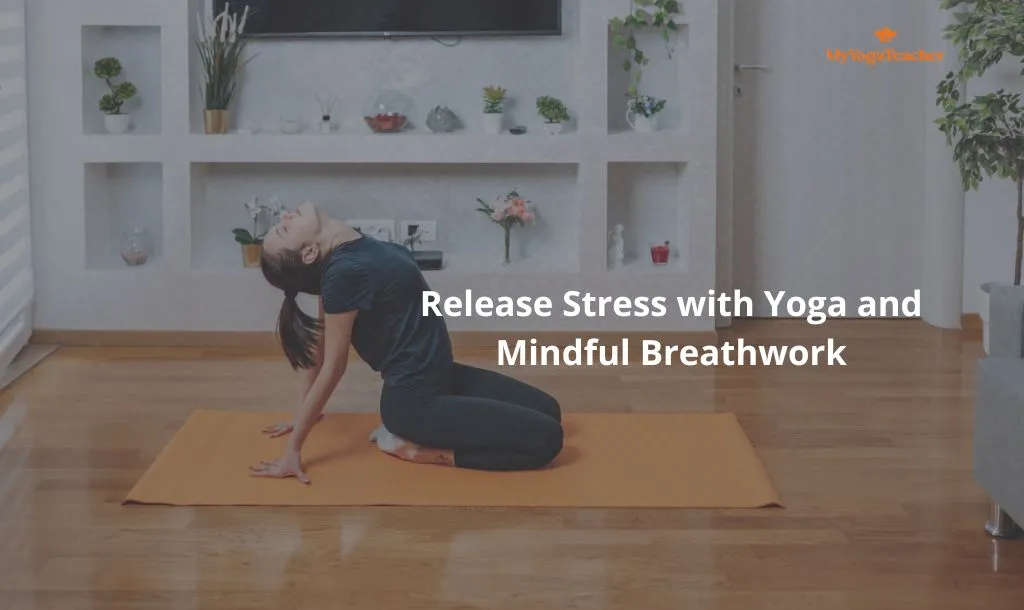
You don’t just feel stress, but you also experience it in your body: tense shoulders, shallow breathing, headaches, digestive issues, and sleep disturbances. In fact, stress is now so common that 1 in 3 people experience it regularly. And the worst part? Most stress relief tips just scratch the surface without addressing both the mind and the body.
That’s where yoga poses for stress relief come in. Backed by science and rooted in tradition, yoga offers a holistic solution. Through mindful movement and guided breathwork, it helps release physical tension, activate your body’s relaxation response, and reset your nervous system from overdrive to calm.
In this guide, you’ll discover the 12 most effective yoga poses for stress relief, along with easy breathing techniques and step-by-step sequences to help you feel better and manage stress effectively.
Several people have reported feeling lighter—mentally and physically—after a yoga session. Wonder why? There’s science to the effects of yoga on the mind and the body.
When you're stressed, your body flips into "fight-or-flight" mode, technically known as the sympathetic nervous system. Heart rate spikes, muscles tighten, and cortisol (the stress hormone) floods your system. But yoga helps by activating the parasympathetic nervous system, also called the “rest and digest” state. This is your body's natural way of recovering, healing, and relaxing.
Each yoga pose you practice does more than stretch your body. It creates pressure and release in key areas like the hips, shoulders, and spine—places where stress often manifests. When combined with mindful breathing, you begin to stimulate the vagus nerve, which plays a critical role in calming your heart rate and reducing stress.
A Harvard Medical School review found that regular yoga practice significantly lowers cortisol levels and reduces symptoms of stress and anxiety. Another study showed that just 10 minutes of yoga-based movement could reduce physiological markers of stress, even in high-pressure environments like corporate offices. Even traditional texts like the Hatha Yoga Pradipika describe asanas as tools to “balance the energies” and prepare the mind for inner peace.
Yoga poses for stress relief work through the body to heal the mind, and vice versa. This helps you think clearly, breathe deeply, and manage day-to-day stress effectively.
Experience the benefits of yoga for stress relief first-hand. Book a free 1-on-1 session with a certified yoga coach today!
Feeling overwhelmed? These 12 yoga poses are your fast track to calm. Backed by science and rooted in tradition, they target the physical symptoms of stress—tight shoulders, racing thoughts, and shallow breathing—helping you feel calmer and more relaxed.
_optimized.webp)
This gentle, restorative pose calms the nervous system, lowers blood pressure, and gently stretches the lower back, which is a common area where stress builds up.
Modifications: Place a bolster or pillow under your chest for support. If you have tight hips, keep the knees closer together.
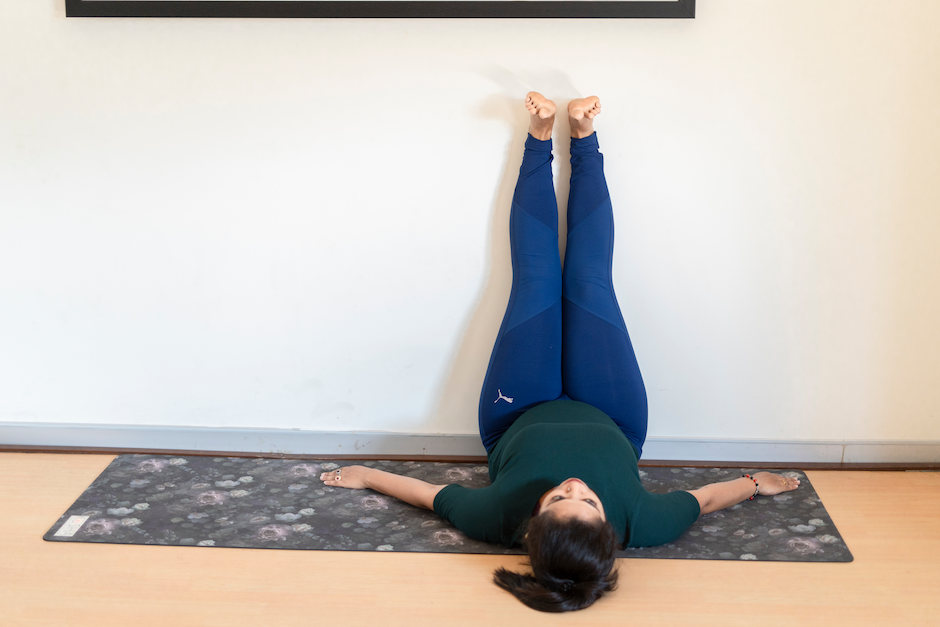
This is a great relaxation pose that reverses blood flow, reduces fatigue, and soothes the heart rate by stimulating the parasympathetic system.
Modifications: Place a folded blanket under your hips for a gentle inversion. In case you have tight hamstrings, scoot slightly away from the wall.

This dynamic flow eases spinal tension, improves breath awareness, and relieves neck and back stiffness.
Modifications: Place a blanket under your knees for cushion. For limited mobility, reduce the range of movement.

This gentle forward bend increases blood flow to the brain, calms the mind, and releases tension in the hamstrings and lower back.
Modifications: Use blocks under your hands or bend your knees generously.
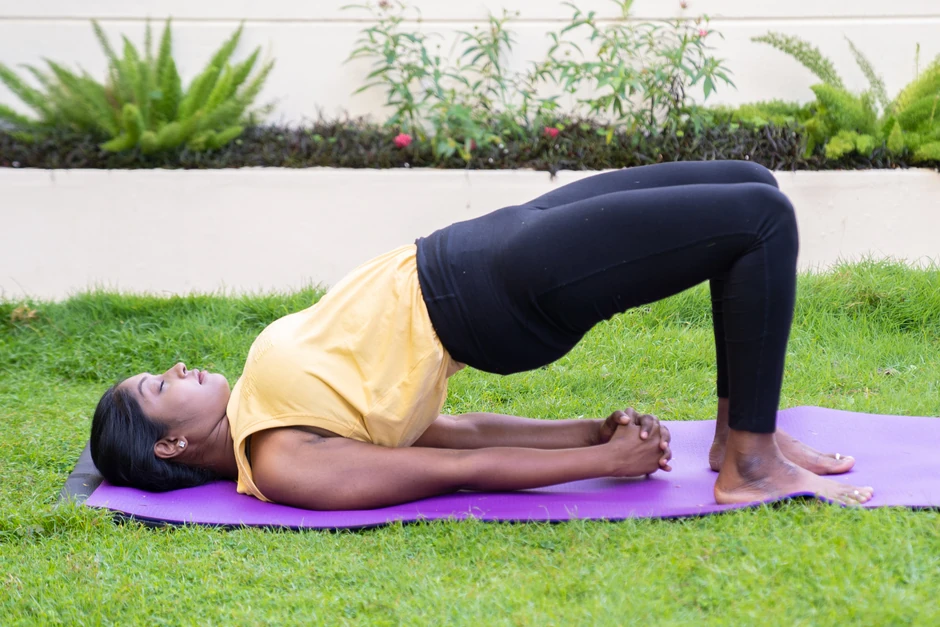
This pose opens the heart, energizes the body, and relieves fatigue and mild depression.
Modifications: Place a block under your sacrum for a supported variation.

This gentle twist releases spinal tension, stimulates digestion (a stress-sensitive system), and improves focus.
Modifications: Keep the bottom leg straight if the full pose is too intense.
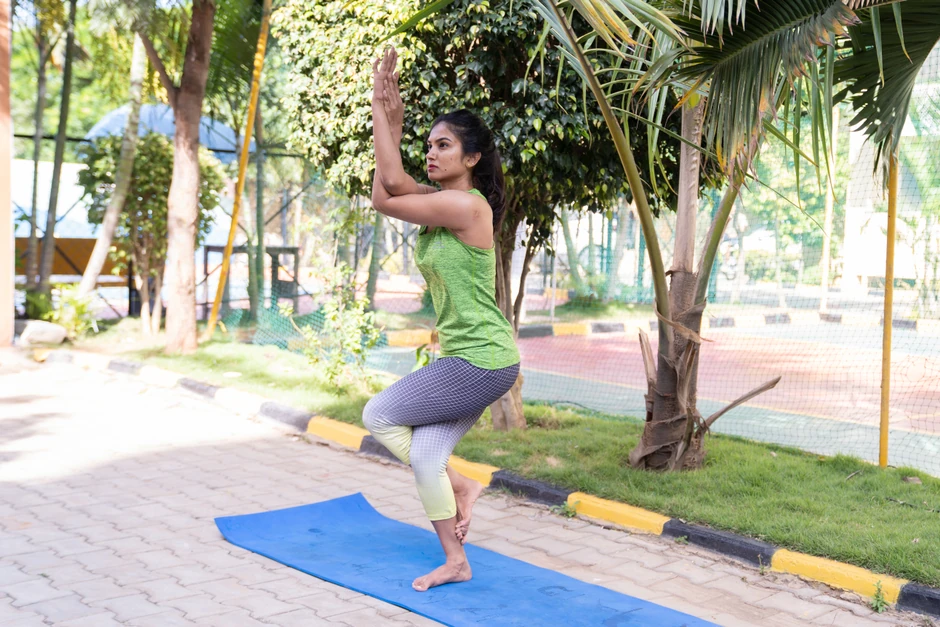
This pose helps enhance focus, relieve shoulder tension, and calm scattered energy.
Modifications: Use a wall for balance. If a full leg wrap isn’t accessible, cross your thighs without hooking.

This deep hip release pose eases emotional tension while promoting grounding and stillness.
Modifications: Use a block or blanket under the hip for support.
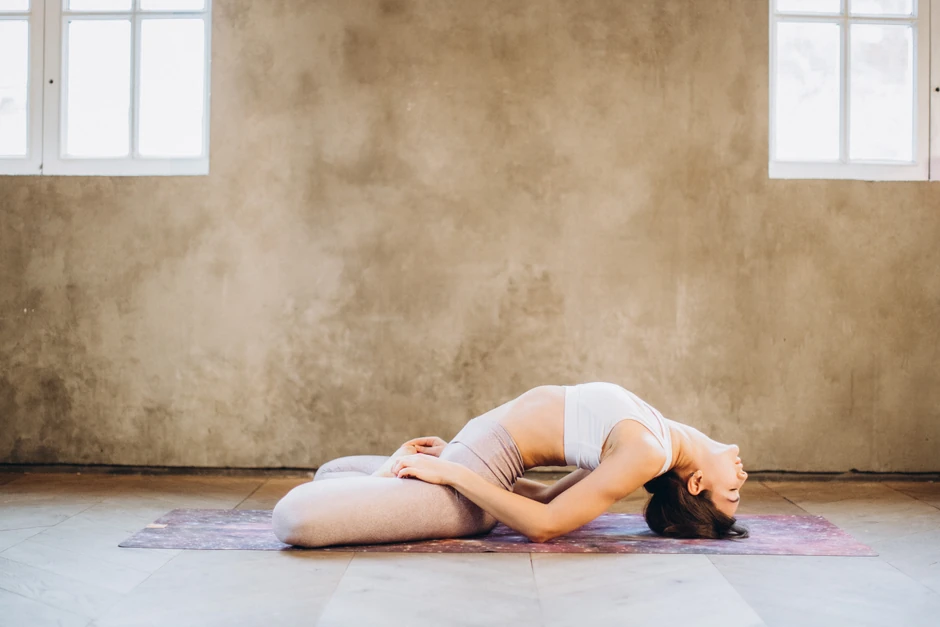
This pose gently opens the chest and throat, improves breathing capacity, and relieves anxiety.
Modifications: Use a folded blanket under the head if the neck feels strained.
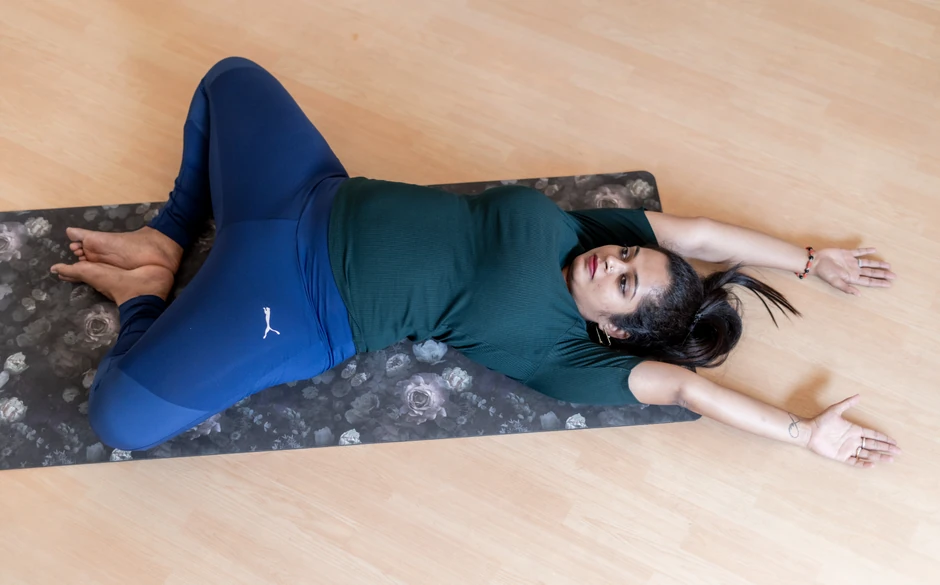
This gentle hip-opening pose also calms the mind and encourages relaxation.
Modifications: Use a bolster under the spine for a heart-opening variation.
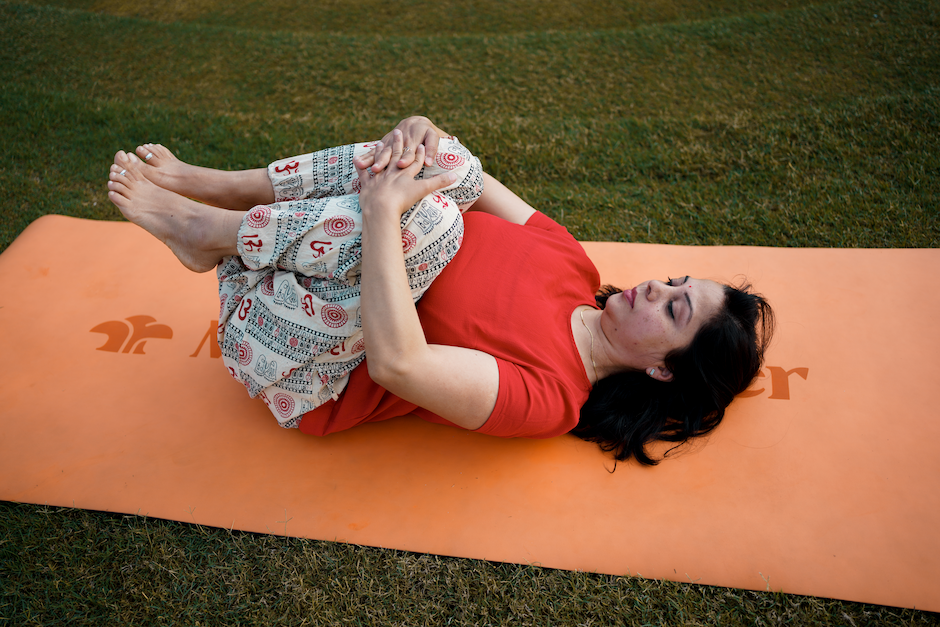
This pose soothes the digestive system, eases lower back tension, and grounds the nervous system.
Modifications: Hug one knee at a time if needed.
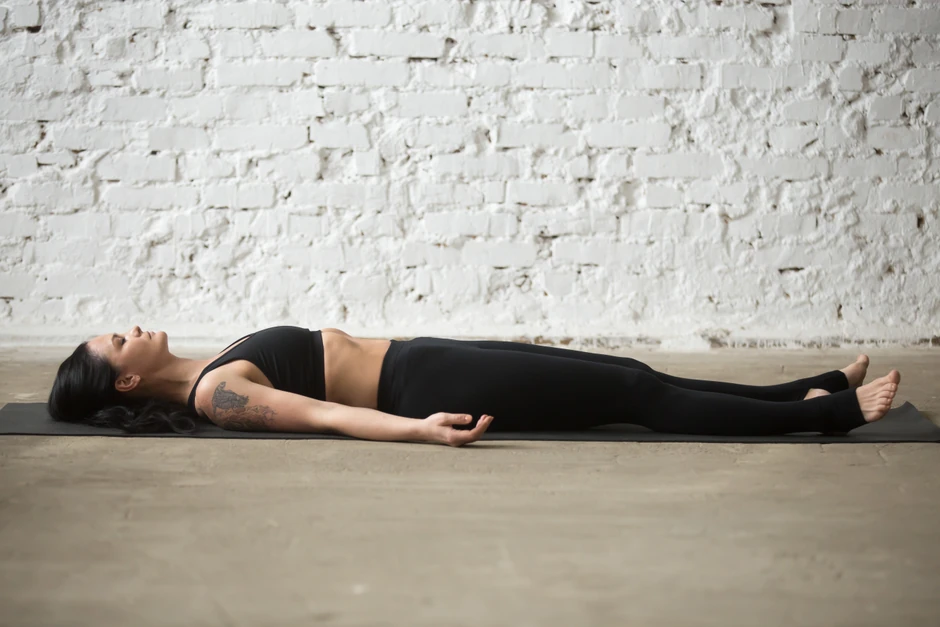
This is the ultimate relaxation pose that ties your practice together, reduces anxiety, and promotes deep healing and rest.
To make the most of your practice, work with a certified coach. Book a free 1-on-1 session today!
When you're stressed, your breath becomes shallow and erratic. When you're calm, it's deep and slow. Yoga helps you stay calm and composed by learning how to actually breathe!
These three powerful pranayama (breathing) techniques are easy to learn, instantly effective, and pair perfectly with yoga poses:
This breathing technique slows heart rate, extends the exhale (key for relaxation), and triggers the parasympathetic nervous system.
This exercise balances the nervous system, improves concentration, and gives a sense of control.
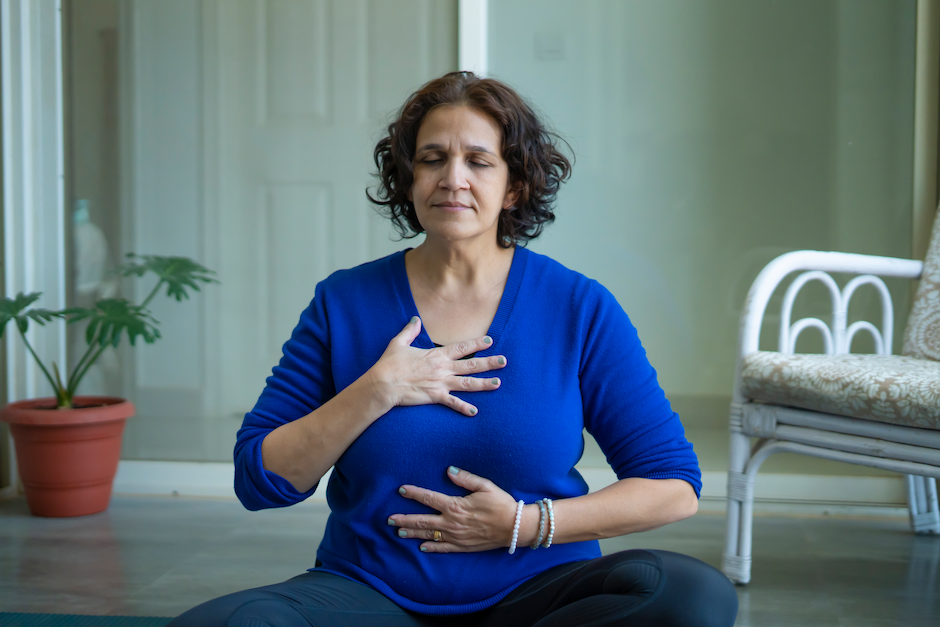
This technique activates the vagus nerve, oxygenates deeply, and trains the body to stay relaxed under pressure.
Want to understand how guided breathing techniques work? Try this free group class on Breathing and Meditation and see for yourself!
Whether you need a break from the stress at work or a restorative wind-down flow for your evenings, there is a yoga sequence for every kind of stress.
Timing your yoga practice strategically can amplify its effects. Here’s how to align your daily yoga for stress relief with your schedule for maximum benefit.
Morning Practice (Energy & Prevention)
Practicing in the morning activates the parasympathetic nervous system early, helps you stay calm through the day, and boosts circulation and mental focus.
Best Poses:
This offers a much-needed relief from stressful meetings, screen time, and endless tasks at work. It helps you reconnect the brain to the body and boost focus.
Best Poses:
Practicing in the evenings helps lower cortisol levels naturally and prepares the body for restful sleep. It also helps process emotional and mental tension built during the day.
Best Poses:
Consistency, not length, is key. Just 5–10 minutes of daily yoga for stress relief can retrain your stress response.
If you’re new to yoga and don’t know how to start for effective stress relief, try this:
By building your yoga routine around your lifestyle, you can make time for your practice easily and stay more consistent.
Need help? Book a free 1-on-1 session today!
With just a few mindful movements and intentional breathwork offered by yoga, you can reset your nervous system, release stored tension, and reconnect with a calmer, clearer you.
These 12 yoga poses for stress relief aren't just exercises, but tools backed by science and shaped by centuries of yogic tradition. And the best part? They’re always available to you for practicing at your convenience.
MyYogaTeacher coaches are available round-the-clock. Whether you need instant relief or want to cultivate long-term stress management skills, they can offer online, live guidance tailored to your requirements.
Book a free session today!
The best yoga poses for stress relief include:
These postures calm the nervous system, release tension from the body, and promote mental relaxation. Each targets different areas where stress accumulates, such as the back, hips, and shoulders.
Hold stress-relief poses for 1 to 5 minutes, depending on the intensity of the pose and your comfort level. Restorative poses like Legs Up the Wall or Reclined Butterfly can be held longer (up to 10 minutes), while active poses like Bridge or Eagle are best held for 30 seconds to 1 minute.
Yes, many yoga poses can provide immediate stress relief by lowering cortisol levels, improving breath flow, and calming the mind. Poses like Forward Fold, Child’s Pose, and deep breathing exercises (e.g., 4-7-8 breathing) are especially effective in reducing stress quickly, often within minutes.
For work stress, choose poses that can be done at your desk or during short breaks. The best include:
Pair these with box breathing for quick, effective midday resets.

Receive personalized guidance tailored to your unique fitness goals, live with a dedicated coach—no credit card required.